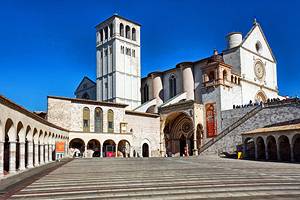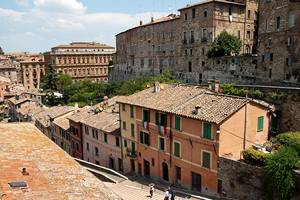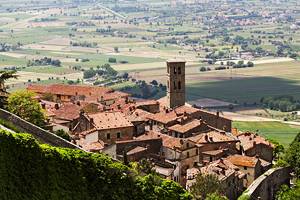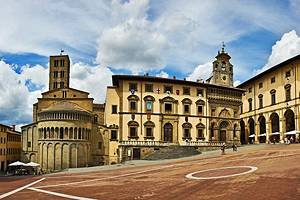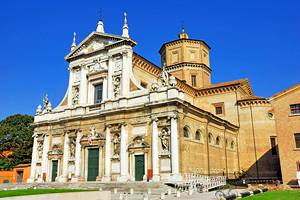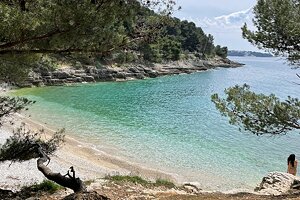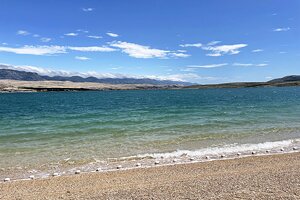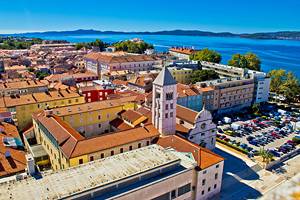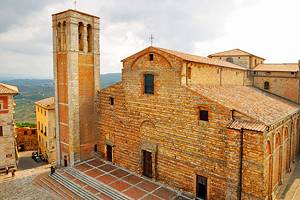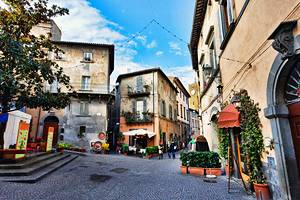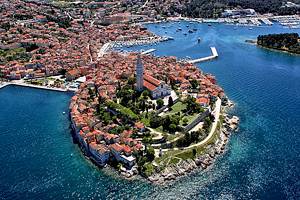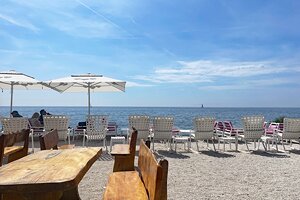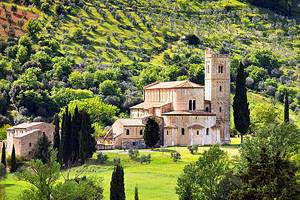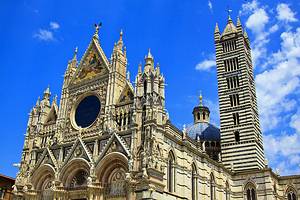Attractions & Things to Do in Ancona
Set picturesquely above the Adriatic Sea, Ancona has only recently been discovered by tourists. Most of them arrive by ferry from Croatia or Greece, or by cruise ship on a shore excursion heading for Loreto or other nearby tourist attractions.
But there are several interesting things to do in Ancona, and repeat cruise passengers have begun to discover the pleasures of its spacious squares, churches, and historic sights, not to mention the white-sand beaches that surround it.
Ancona is capital of the Marches region and has been an important trade center since Roman times, when the Emperors Caesar and Trajan fortified and developed it into a naval base. Explore its rich history and discover the best places to visit with our list of the top attractions in and around Ancona.
Harbor and Piazza della Repubblica
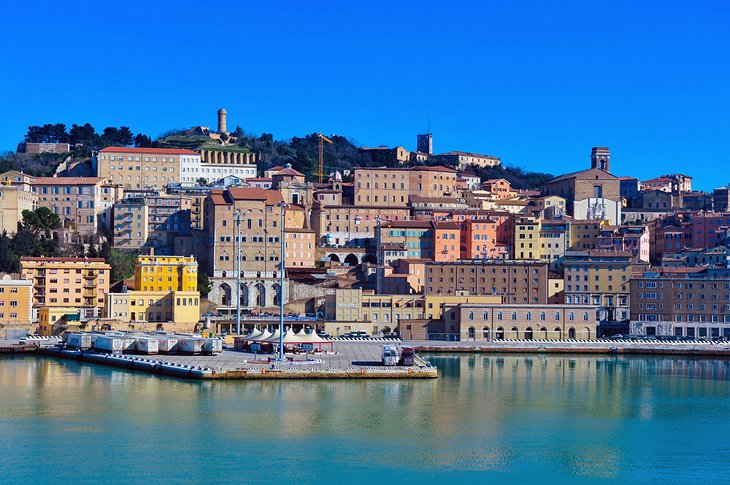
The hub of Ancona's traffic—both land and sea—is Piazza della Repubblica. On its west side is the harbor, a large oval basin that has been in use since Roman times. At the north end of the breakwater is the Roman triumphal arch, Arco di Traiano, with an inscription recording that it was erected in AD 115 in honor of the Emperor Trajan and his wife and sister.
This area was the Roman Lungomare Vanvitelli, and a large archaeological dig has uncovered the remains of the port structure and stretches of the wall built in the second century BC to protect the port. You can tour the area on raised walkways. The Arco Clementino to the west is from the 18th century.
Cattedrale di San Ciriaco
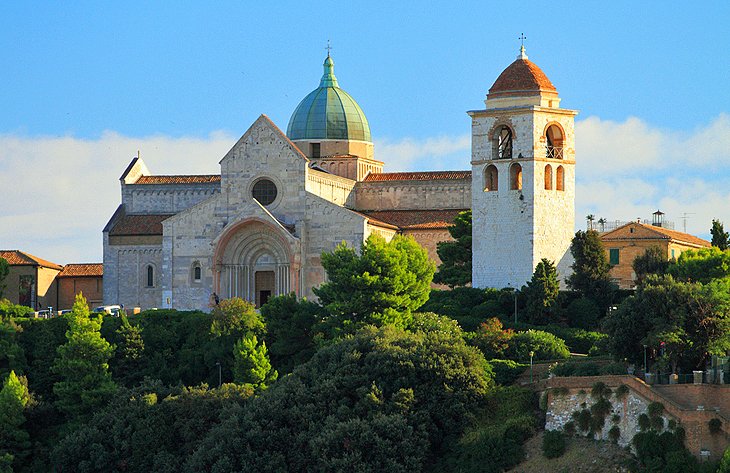
A flight of steps or a winding panoramic road leads to the top of Monte Guasco, where Ancona's cathedral was built on the site of a temple dedicated to Venus Euplea, the goddess who protected sailors.
You can see bases of that temple's columns through glass panels in the floor, as well as remains of an earlier paleo-Christian church from the sixth century in the crypt. The domed cruciform church in Byzantine-Romanesque style is from the 12th century, and the façade has a Gothic doorway, which is decorated with reliefs. From the top are spectacular views over the city and Adriatic coast.
Address: Piazzale del Duomo, Ancona
National Archeological Museum
The 16th-century Palazzo Ferretti houses one of the most prestigious archaeological museums in Italy, filled with the finds that emerged from excavations throughout the Marche region. It is especially strong in prehistoric and Roman artifacts from tombs, but it covers everything from the Paleolithic era to the Early Middle Ages.
The 23 rooms devoted to primitive history give a good sense of these people's daily lives, including everything from tools and weapons to cooking pots and early jewelry. Palazzo Ferretti itself is worth seeing, and is an especially good example of 16th-century (and later) architecture with frescoes by Pellegrino Tibaldi.
Address: Palazzo Ferretti, Via Ferretti 6, Ancona
The Beaches of Monte Conero
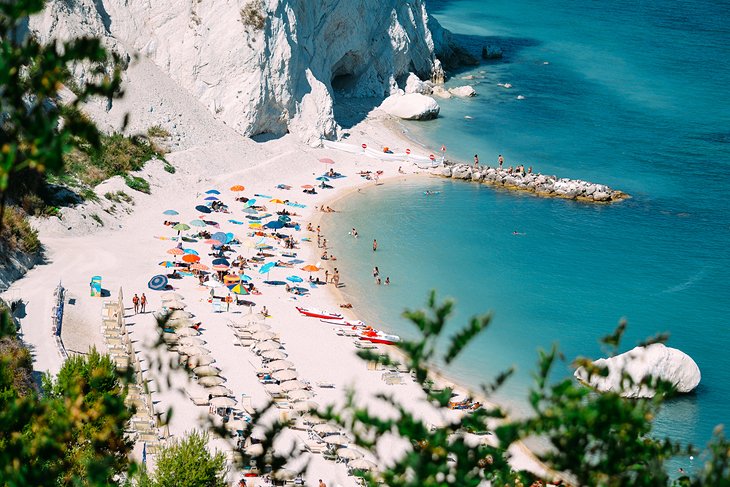
South of Ancona, Monte Conero rises 572 meters above the sea, a rocky promontory that's a regional park and a protected ecological area. More than a dozen hiking trails weave throughout the park, and at the foot of dramatic limestone cliffs are 20 km of coastline bordered by lovely white beaches with calm blue-green waters for swimming. Five of these are Blue Flag beaches; some are accessed only by walking trails or by boat.
At the northern end of the park, closest to Ancona, the remote Mezzavalle Beach is reached by a path and has a small café. The long Portonovo Beach sits under a promontory and can be reached by a shuttle bus from the town above. Near the beach at Portonovo is the Romanesque church of Santa Maria di Portonovo, built in 1034 of white of Conero limestone.
The lovely pebble beach of Two Sisters is accessed by boat and has no beach-side services, but it's one of the most beautiful on the Adriatic coast. Snorkelers don't mind having to walk to the rocky shoreline of Sasi Neri, near Sirolo, for its crystal clear blue water. The town of Sirolo has much of its past intact, and the feel of a medieval village of narrow streets and piazzas with views of Mount Conero and the beaches below.
The beach of Numana Alta is a more holiday resort feel, with several restaurants, umbrellas for rent and more people, but the beach is lovely and the water clear. The old fishing village of Numana, now a popular beach getaway, was a Roman port, repeatedly sacked in the Middle Ages. Little is left of its past, but a sandstone arch overlooking the sea was once part of a medieval church.
Day Trip to the Santuario della Santa Casa in Loreto
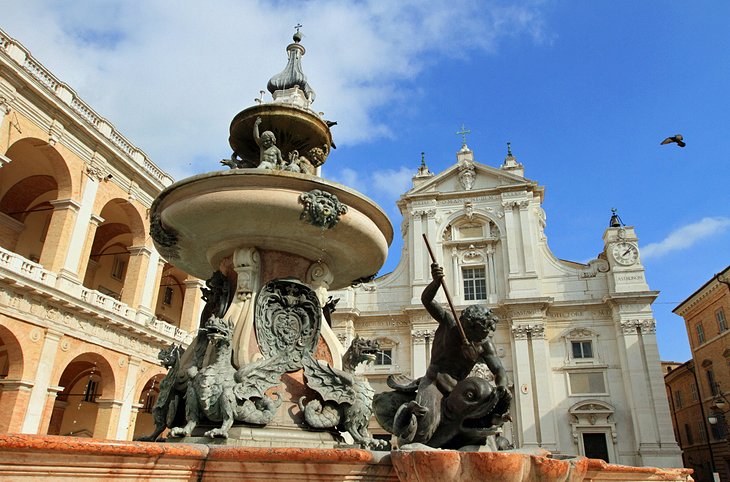
The little town of Loreto lies on a hill near the Adriatic Sea, about 20 kilometers south of Ancona. Since the 14th century, it has been Italy's second most important place of pilgrimage after Rome.
According to legend, in 1291, the Virgin's house in Nazareth, the Santa Casa, was transported by angels to a succession of sites, and finally, in 1295, to its present site in Loreto. The Santuario della Santa Casa, a Gothic hall-church with a fortress-like exterior, was begun in 1468 and completed with the raising of the dome in 1500.
The late Renaissance façade was added in 1583-87. The three bronze doors are decorated with figures and bas reliefs. The interior of the church has a beautiful baptismal font from 1607, and the two sacristies have 15th-century frescoes by Melozzo da Forli and Luca Signorelli.
Under the dome in the center is the Santa Casa, a simple brick building surrounded by a high marble screen designed by Bramante in the 16th century. On the walls are scenes of the life of the Madonna and of the transportation of the Santa Casa to Loreto. In the same piazza, opposite the sanctuary, is the Palazzo Apostolico, with paintings, tapestries from designs by Raphael, and majolica from Urbino.
Address: Piazza della Madonna, Loreto
Piazza del Plebiscito
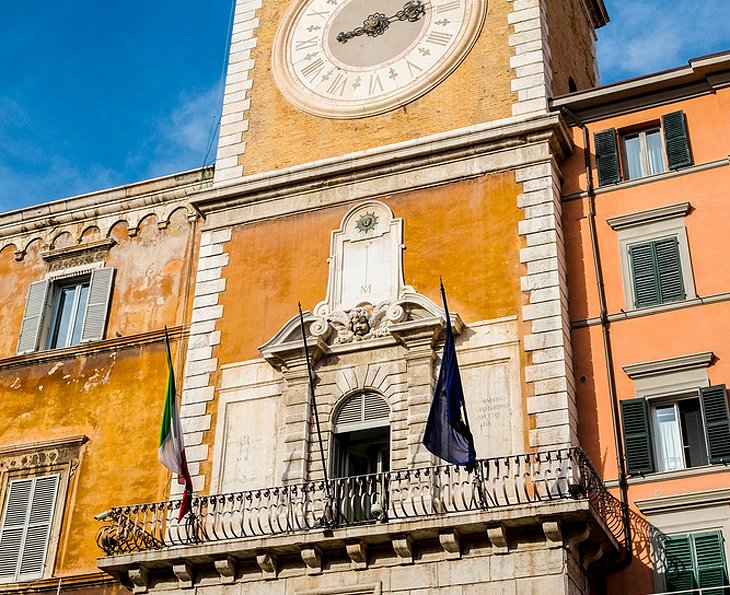
This long piazza is Ancona's favorite spot to relax or meet friends in a café, a gracious outdoor space overlooked by statues and historic public buildings. High at one end is the church of San Domenico, designed by Marchionni and built in the late 1700s. Inside, you'll find a painting of the Crucifixion by Titan.
Bordering the square are the Palazzo Mengoni Ferretti, the Civic Tower, and the 15th-century Palazzo del Governo. To the west of the Palazzo del Governo is the Loggia dei Mercanti, a late Gothic building with a facade by Giorgio Orsini, and adjoining it, the beautiful 15th-century Palazzo Benincasa.
At one end is a statue of Pope Clement XII, and in front of it are two fountains: one from the 19th century and the other dating from the 15th century, its top layer decorated by effigies.
Touch the Art at Museo Tattile Statale Omero
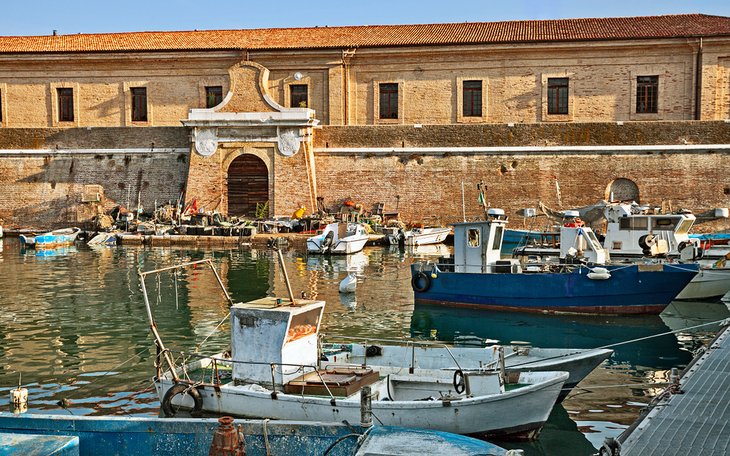
At Ancona's harbor stands the massive Mole Vanvitelliana, a pentagonal building that was once a quarantine station. Today it houses one of Italy's most unusual art museums. The barriers and alarms that normally prevent visitors from touching or getting close to works of art are absent here, and visitors are invited and encouraged to touch, experiencing works of art in a multisensory way.
Described as a "three-dimensional encyclopedia of art history," the museum covers all the major eras of sculpture and architecture, with casts taken from ancient Greek masterpieces and some of Michelangelo's best-known sculptures. Actual original works are by mid-century and contemporary sculptors, including Giorgio De Chirico and Arturo Martini.
Architectural icons that visitors can explore include models of the Pantheon and St. Peter's Basilica. These are cut-away reproductions that show the interior and construction details. Models of town squares, castles, and churches, along with casts of bas reliefs, represent the Middle Ages.
In another section, famous paintings are converted into 3-D images that visitors can reach into and touch. Admission to this extraordinary museum is free.
Address: Mole Vanvitellia, Banchina Giovanni da Chio 28, Ancona
Official site: https://www.museoomero.it/en/
Roman Amphitheater
Built into the slope of Monte Guasco, on top of which stands the cathedral, are the ruins of Ancona's large Roman amphitheater, which was built during the reign of Emperor Augustus. It held as many as 10,000 spectators, but only one level of these terraces remains today, along with two entrances.
Attached to the amphitheater is a building believed to have been a gladiator school, decorated in mosaics also from the Augustan Age. An annex has thermal baths with excellent mosaics. If you look carefully, you'll see neighboring buildings that follow the original shape of the theater complex.
Address: Piazza Anfiteatro, Ancona
Santa Maria della Piazza
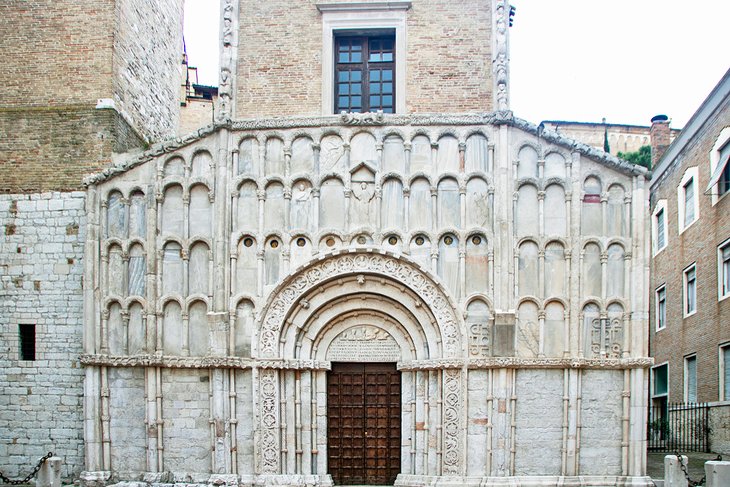
Inside the early 13th-century church of Santa Maria della Piazza, you can see the remains of the floor of a 6th-century church, one of the two on whose foundations the present church was built. The portal is intricately carved, and the lower part of its highly decorated façade is faced in Dalmatian marble and elegantly decorated with small arches.
The upper portion of the façade was never finished. The interior is simple, in the form of a Latin cross, with a nave, two aisles, and a raised altar. The entire church is an excellent example of Romanesque architecture and, with the cathedral, one of Ancona's two most significant churches.
Address: Piazza Santa Maria, Ancona
Passetto and War Memorial
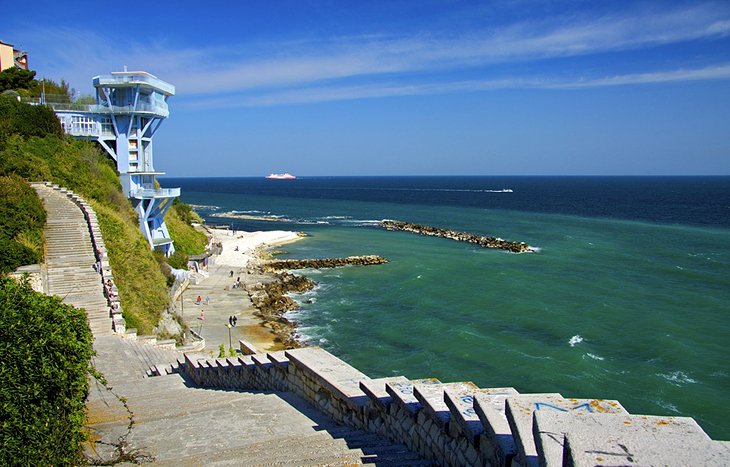
Atop the high hill above the sea and Passetto Beach is the white marble Passetto Monument, a World War I memorial built in 1930 and heavily influenced by fascist-era style and decorative motifs. It stands at the top of a long double staircase that descends in matching curves to the beach below.
An interesting feature of the beach (in the summer you can use the modern elevator instead of the stairs) is the old fishing port with caves carved into the rock cliff in the early 1900s, originally used by fishermen to store boats and tackle. The views from the top, in front of the monument, can extend to the Croatian coast on a clear day.
Address: Via Vittoria, Ancona
Museo Diocesano
The diocesan museum is in the former Bishop's Palace to the left of the cathedral and contains not only the cathedral's treasury, but works of art from other churches, some of which were destroyed or irreparably damaged during World War II, when Ancona's port was heavily bombed.
Among these is a reconstruction of the portal of the Romanesque church of San Pietro. Also notable are the early Christian sarcophagus with carved decoration belonging to Flavius Gorgonius, a praetorian prefect in the fourth century, and the sarcophagus of San Dasio, a sixth-century martyr.
Address: Piazza Duomo 9, Ancona
Ancona - Climate Chart
| Average minimum and maximum temperatures for Ancona, Italy in °C | |||||||||||
| J | F | M | A | M | J | J | A | S | O | N | D |
| 9 1 | 10 2 | 13 4 | 17 7 | 22 11 | 25 14 | 28 16 | 28 17 | 24 14 | 20 10 | 14 6 | 10 2 |
| PlanetWare.com | |||||||||||
| Average monthly precipitation totals for Ancona, Italy in mm. | |||||||||||
| 51 | 53 | 69 | 53 | 61 | 56 | 53 | 84 | 74 | 71 | 79 | 74 |
| Average minimum and maximum temperatures for Ancona, Italy in °F | |||||||||||
| J | F | M | A | M | J | J | A | S | O | N | D |
| 47 33 | 50 35 | 56 39 | 62 44 | 71 51 | 77 58 | 82 62 | 82 62 | 76 57 | 67 50 | 57 42 | 50 36 |
| PlanetWare.com | |||||||||||
| Average monthly precipitation totals for Ancona, Italy in inches. | |||||||||||
| 2.0 | 2.1 | 2.7 | 2.1 | 2.4 | 2.2 | 2.1 | 3.3 | 2.9 | 2.8 | 3.1 | 2.9 |
More Related Articles on PlanetWare.com
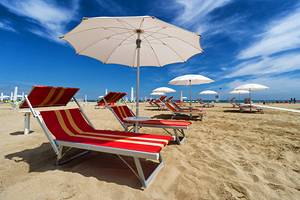
Where to Go from Ancona: The Adriatic coast north of Ancona offers several options for touring. The popular resort of Rimini is a wonderful place for sun and sand with some of the best beaches in Italy and is only a few kilometers from the principality of San Marino.
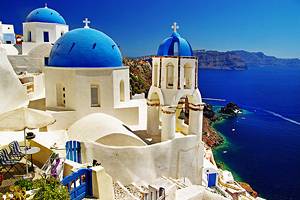
By Ferry from Ancona: The busy port is the jumping-off place for destinations across the Adriatic, including the island of Corfu and Patras, from which you can reach the tourist attractions of Greece. Perhaps the most popular route takes you to the Croatian city of Split.





